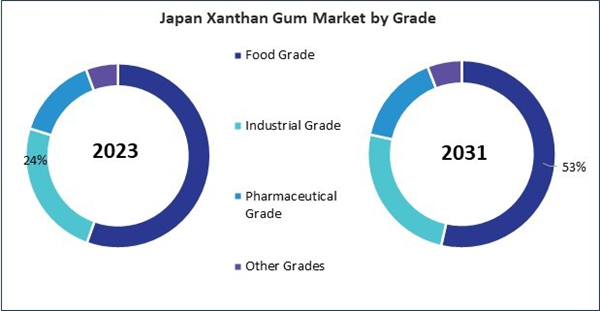In Food & Beverage segment, this gum is widely used as a thickener, stabilizer, and emulsifier in various food products such as sauces, salad dressings, dairy alternatives, and gluten-free baked goods. It improves texture, enhances shelf life, and prevents ingredient separation. It’s particularly valuable in gluten-free and low-fat products, where it replicates the binding and thickening properties of gluten or fats. Thus, the Food & Beverage segment in China market Consumed a volume of 3,007.97 Tonnes in 2023.
The China market dominated the Asia Pacific Xanthan Gum Market by Country in 2023, and is expected to continue to be a dominant market till 2031; thereby, achieving a market value of $219.4 million by 2031. The Japan market is registering a CAGR of 8.1% during 2024-2031. Additionally, the India market is expected to showcase a CAGR of 9.7% during 2024-2031.
The adoption of this gum has experienced significant growth across various industries, driven by its unique properties, versatile applications, and numerous advantages over traditional additives. For instance, this gum offers many functionalities, including thickening, stabilizing, emulsifying, and suspending properties, making it a versatile ingredient in various formulations. Its ability to create stable gels, adjust viscosity, and improve texture and mouthfeel makes it indispensable in food products ranging from sauces and dressings to bakery goods and dairy alternatives.
Similarly, this gum's stabilizing qualities prolong food items' shelf life by averting ingredient separation, enhancing texture uniformity, and minimizing syneresis. Processed foods and beverages help maintain product quality during storage and distribution, ensuring a consistent sensory experience for consumers. Similarly, the natural origin and biodegradable characteristics of this gum correspond with the growing customer preference for environmentally friendly and sustainable products.
With the expansion of the food processing industry in India, there's a growing need for ingredients that enhance the texture, stability, and overall quality of processed foods. This gum fits these requirements perfectly, leading to a rise in its demand. India's food processing industry is expected to reach $535 Bn and will grow at a rate of 15.2% by 2025. Tier-II and Tier-III cities could mirror the trend visible in metropolitan areas by consuming more processed food in the coming years. The demand for superior-quality cosmetics has increased the need for high-performance stabilizers and thickeners like xanthan gum.
This component aids in preserving the steadiness and uniformity of items like creams, lotions, and gels. South Korea’s cosmetics industry is renowned for its continuous innovation and rapid product development cycles. Therefore, expansion of the food process industry and increasing cosmetics sector in the region is propelling the growth of the market.
List of Key Companies Profiled
- Cargill, Incorporated
- DuPont de Nemours, Inc.
- Archer Daniels Midland Company
- Foodchem International Corporation
- Desosen Biochemical (Ordos) Ltd.
- Tate & Lyle PLC
- Ingredion Incorporated
- Solvay SA
- Bob's Red Mill Natural Foods, Inc.
- Meihua Holdings Group Co, Ltd
Market Report Segmentation
By Form (Volume, Tonnes, USD Billion, 2020-2031)
- Powder
- Liquid
By End Use Industry (Volume, Tonnes, USD Billion, 2020-2031)
- Food & Beverage
- Oil & Gas
- Pharmaceutical
- Personal Care & Cosmetics
- Other End Use Industries
By Grade (Volume, Tonnes, USD Billion, 2020-2031)
- Food Grade
- Industrial Grade
- Pharmaceutical Grade
- Other Grades
By Country (Volume, Tonnes, USD Billion, 2020-2031)
- China
- Japan
- India
- South Korea
- Australia
- Malaysia
- Rest of Asia Pacific
Table of Contents
Companies Mentioned
- Cargill, Incorporated
- DuPont de Nemours, Inc.
- Archer Daniels Midland Company
- Foodchem International Corporation
- Desosen Biochemical (Ordos) Ltd.
- Tate & Lyle PLC
- Ingredion Incorporated
- Solvay SA
- Bob's Red Mill Natural Foods, Inc.
- Meihua Holdings Group Co, Ltd









